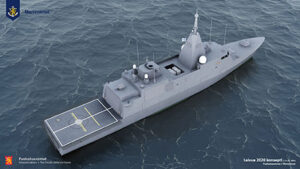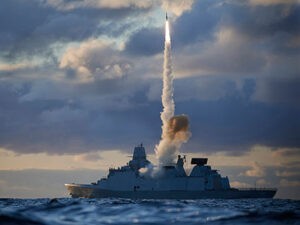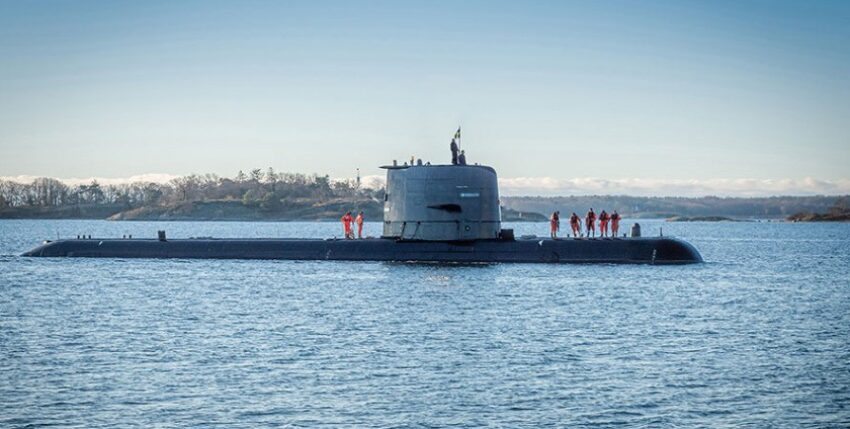The Russian-Ukrainian war also had a major impact on the navies of the Baltic Sea states. They were already in the process of rebuilding capacities that had been radically curtailed after the Cold War.
Historically neutral Sweden is one of the countries whose security architecture has been most affected by recent Russian aggression, a fact that is most evident in the country's impending accession to NATO. The country is already in the midst of a major military revitalisation programme called Totalförsvaret 2021-2025 (which translates roughly as Total Defence), which was passed by the Swedish parliament at the end of 2020. From the navy's perspective, the focus has thus shifted back to defending the Baltic Sea, after international stabilisation missions had previously been the main focus.
The most important aspect of this was the modernisation of Sweden's underwater capabilities. This is linked to two contracts with Saab from 2015, which included the modernisation of two of the three Gotland-class submarines and the construction of two new successor units, the Blekinge-class. The modernisation of the Gotland class essentially ensures that the existing submarine flotilla remains operationally relevant. At the same time, it helps to renew the relevant infrastructure and initiate technological progress with regard to the Blekinge class. Key elements of the €189 million update included the installation of a two metre hull section to make room for additional equipment and the installation of the latest Mk-4 version of the air-independent Stirling propulsion system. It also includes modernisations in the sensor and communications area. The original contract was completed with the return of the Uppland, the second boat to be modernised, to the Swedish Defence Materiel Administration in December 2020. Totalförsvaret 2021-2025 also allows the third boat in the class, the Halland, to be modernised to increase the number of operational boats to a total of five. In March 2022, a contract worth 99 million euros was signed with Saab to carry out the necessary work.
The construction of the new Blekinge class was a different order of magnitude. The contract signed in 2015 stipulated that the two boats would be delivered between 2022 and 2024 at a cost of around 685 million euros. However, Saab had difficulties meeting both the timeframe and the budget. This was due to the significant expenditure required to revitalise the design and engineering capabilities in Karlskrona following the acquisition by Thyssenkrupp Marine Systems. In August 2021, Saab announced that the delivery of the two new submarines would be postponed to 2027 and 2028. In addition, the Defence Materiel Administration had allocated a further 468 million euros for the completion of the project and for an (unspecified) expansion of the boats' capabilities. The delay explains the further decision to extend the service life of the modified Södermanland submarine, which dates back to the 1980s, by a further six years. The contract was awarded in September 2022. Progress on the construction of the Blekinge class is highlighted by the keel laying ceremony on 30 June 2022 at Saab Kockums' Karlskrona shipyard. At that time, the first two completed hull sections of construction number one were presented.

The modernisation of Sweden's most important surface units, the five existing Visby-class corvettes, is proceeding in a similar way to the submarines and is a top priority. It is scheduled to begin by 2025. In addition to improving existing capabilities, a surface-to-air missile system will be introduced. The capability profile for a second generation of the Visby class is also being developed, which will eventually replace the four units of the Stockholm and Gävle classes on a one-to-one basis. These will rely heavily on the technology used to modernise the current Visby units and it is intended that the first two ships will be in service by 2030. In the meantime, the current surface fleet will be bolstered by the return to operational service of the Gävle and her sister Sundsvall after they complete their own mid-life upgrades during 2022.
The modernisation of the submarines and larger surface units will be supplemented by investments in smaller boats and auxiliary vessels. This includes the mid-life extensions for mine countermeasures vessels and the ongoing modernisation of the CB-90 series flotilla of fast attack boats. An autonomous variant with the designation Enforcer III is currently undergoing trials. Other important modernisation programmes include Saab's new Torpedo 47 lightweight torpedo, a life extension for the Torpedo 62 heavyweight torpedo and the latest variant of the RBS 15 ship-to-ship missile, the Mk IV Gungnir.
The new defence law planned for 2023 has raised hopes of additional procurements for the navy. Increasing the number of submarines to six is emerging as a priority. This would most likely result in the construction of a third Blekinge-class boat. In addition, Saab is researching and developing a successor design - provisionally referred to as the UB-30 concept - that could replace the Gotland class.
Finnish similarities
The reasons for the introduction of a new Finnish defence strategy are based on similar considerations as in neighbouring Sweden. These include the implementation of a "comprehensive" security policy that focuses on territorial defence. And, of course, the joint decision to seek NATO membership following the Russian invasion of Ukraine. The procurement of naval units was also similar to Sweden. A comprehensive renewal of the Hamina-class surface units and the acquisition of new Pohjanmaa-class corvettes are planned. Interestingly, much of the equipment used in both projects is of Swedish origin.
The Pohjanmaa class is the result of the Squadron 2020 project, which was developed to replace seven older units of different types with a quartet of larger and more powerful warships. With a displacement of almost 4000 tonnes, the new corvettes will be the largest ships ever operated by Finland. As multi-purpose units, they will be able to be used for naval warfare above and below water, against air targets and for action on land. A contract worth 648 million euros was signed with Rauma Marine Constructions in 2019 after considerable hesitation. The original plan envisaged the start of production in 2022 and the delivery of all four ships by 2028. Although components with long delivery times had already been procured, the construction of the new ships was delayed. As a result, the originally planned delivery dates now look rather optimistic.
The mid-life upgrade of the four Hamina-class ships is closely linked to the acquisition of the Squadron 2020 and is sometimes referred to as the Squadron 2020 MLU. Much of the equipment planned for the new corvettes is intended to emphasise the similarities between the two classes. There is a particular focus on submarine hunting. The project appears to have progressed relatively smoothly and was successfully completed in September 2022 with the return of the Pori, the fourth and final ship to receive the upgrade.
A number of smaller acquisitions are also underway. These include a series of nine 21.5-tonne Üto-class fast landing craft ordered from the Finnish shipyard Kewatec. The first unit was delivered in August 2022, with the remainder due to be in operation by 2024. In addition, a replacement for the Kuha- and Kiiski-class coastal minesweepers built in the mid-1970s was put out to tender.
Shift in focus
Danish security policy is also changing as a result of the perceived threat. Defence spending will increase steadily in order to achieve the NATO two-percent target over the next ten years. With the positive outcome of the June 2022 referendum on participation in the European Union's defence policy, the country is moving closer to the community. After the end of the Cold War, the Royal Danish Navy neglected its Baltic obligations. The focus was now on the country's distant northern territories and global maritime trade interests. It is likely that the additional funding provided under the new policy will enable a refocus on the maritime areas on the doorstep.
Details on future naval procurement will only be announced once the 2018-2023 defence agreement has been replaced. This included only modest investment in the fleet. This included the long-delayed acquisition of a limited inventory of SM-2 missiles for the three Iver Huitfeldt-class frigates. A comprehensive programme to upgrade the fleet appears to be on the horizon. In August 2022, the then Danish Defence Minister Morten Bødskov declared that around 5.4 billion euros would be invested in new warships in the coming years. He announced a new partnership with the industry to maximise local participation in the project. The lack of past investment in naval shipbuilding means that much of the infrastructure has been lost. Accordingly, a key objective of the partnership is to identify how best to strengthen indigenous shipbuilding capacity before embarking on a new phase of procurement.

More than mine action
Although the Baltic republics had few illusions about the potential for Russian aggression, the capabilities of their navies remained modest. Only the maintenance of effective mine defence capabilities has been a priority. As a result, small flotillas of modernised former British (Estonia and Lithuania) and Dutch (Latvia) minesweepers form the focus of all three fleets. In July 2022, the acquisition of a third modernised Hunt-class mine countermeasure boat by Lithuania was confirmed. The former HMS Quorn will now undergo a €74 million upgrade at Harland & Wolff's Appledore shipyard before formal delivery in 2024. In October 2021, Estonia procured Blue Spear surface-to-surface missiles from the joint venture IAI and ST Engineering Land Systems Proteus Advanced Systems. This could herald a broader reorientation towards the procurement of more offensive technology by the Baltic states.
With foreign support
Poland's current defence policy was defined in a strategic review initiated in 2016 and described in detail in the Republic of Poland's defence concept the following year. According to this draft, the navy continues to be given a lower priority compared to the other branches of the armed forces. Its task remains the defence of the Polish coast and the southern Baltic Sea. This rather low status has been reflected in limited progress in the modernisation of the navy in recent years, with a number of programmes being gradually postponed. At this stage, it is not clear to what extent the deterioration in relations with Russia will lead to an overhaul of Poland's overall security architecture. The changed geopolitical environment could offer better prospects for the realisation of existing procurement plans. They are included in a Technical Modernisation Plan 2021-2035 (TMP), which also lists naval acquisitions.
The modernisation of the Polish submarine flotilla continues to be a high priority for the TMP. In addition, the modernisation of the large surface units also appears to be a priority. This is being implemented in the Miecznik programme (German: Schwertfisch) by a local consortium. According to the original plans, three corvette-sized ships were to be built, but a trio of much larger frigates is now being prioritised. The project envisages the local construction of a licence design with corresponding technical support. In March 2022, the selection of the Arrowhead 140 design by British company Babcock International was announced. MBDA UK and Thales UK will contribute in the areas of command and control, weapons employment management, sensor and missile technology. In September 2022, Babcock reported the signing of a development agreement in preparation for the start of construction, which is expected to take place before the end of 2023. The agreement provides for a technology transfer. The first ship is scheduled to be delivered in the course of 2028 and the project is expected to be completed by 2031. The estimated programme costs in mid-2021 amounted to 1.7 billion euros.
The realisation of the Miecznik project undoubtedly represents a major challenge for Polish industry. The construction of the only large warship built locally in recent times, the Meko A-100 class corvette Ślazak, took around 18 years. However, the progress made by Remontowa Shipbuilding - a key member of the Miecznik consortium - in delivering a trio of new Project 258 Kormoran II mine defence vessels is promising. The Albatros - the second unit of this class - was delivered in August 2022, while the third ship, named Mewa, is currently in the final phase of sea trials. In June 2022, the Polish Ministry of Defence signed a contract for a second batch of three more ships of this type for delivery between 2026 and 2027, at a reported cost of 530 million euros.
In the longer term, the TMP also envisages the local construction of six light, missile-carrying units as part of the Murena programme, as well as the aforementioned submarines. The latter project is known as Orka and is struggling to gain traction despite the reduction of the current submarine fleet to the remaining older Kilo-class boat, the Orzel. Although various means such as the purchase or leasing of second-hand submarines have been explored, a planned purchase is likely to be delayed until the Miecznik programme shows further progress. Whether the planned increase in Polish defence spending as a result of the Russian-Ukrainian conflict will help to strengthen the three-unit programme remains to be seen.
Conrad Waters is a member of the editorial board of our international sister magazine Maritime Defence Monitor.
Conrad Waters










